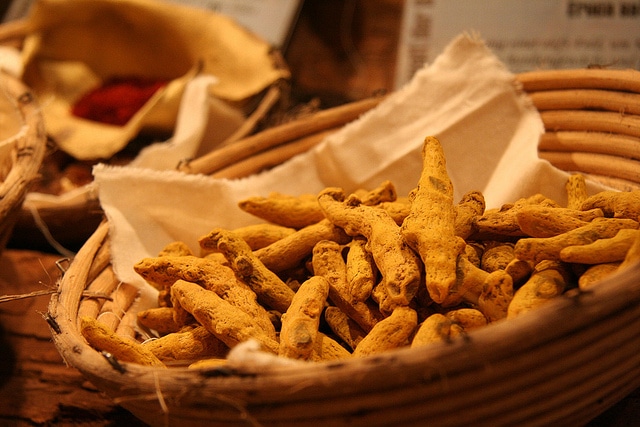Curcuma longa, also known as turmeric (terra merita) or, more popular, Indian saffron, is a perennial herbaceous plant of the ginger family Zingiberaceae and gives the name of a famous spice. The plant originates in the Indian subcontinent and needs a tropical climate and abundant rainfall to grow.
Curcuma is one of the few spices used both as spice and in the treatment of many diseases. In India it has been appreciated for thousands of years for its curative properties, being a major component of Ayurvedic medicine.
Seasoning is produced from the plant rhizome which, after harvesting, boils for several hours and is left to dry. Finally, it is ground in a yellow-orange powder. Curcuma has a spicy and bitter aroma, and its scent reminds of ginger with which it also blends.
The main turmeric producers are India, Indonesia and China. Recently, spice has come to be used in Europe as well.
Which nutrients contain curcuma and what benefits does it bring to the body?
Curcuma is an excellent source of iron and manganese and a good source of vitamin B6, fiber and potassium.
In recent years, the beneficial properties of turmeric consumption have been extensively studied. Before entering Europe, the Chinese and Indians were known as a remedy for a wide range of affections: from heart disease or menstrual pain to toothache or bruising.
Recent studies have shown that volatile oils in this plant have anti-inflammatory properties and have proven effective in the prevention of cancer, Alzheimer’s disease and liver disease. Moreover, curcuma contains a yellow-orange pigment called curcumin, which is said to have effects similar to strong drugs such as hydrocortisone and phenylbutazone, but without the toxicity of the latter. Curcumin, along with quercitin, another nutritional substance in this spice, has antioxidant powers and destroys precancerous colon cells.
Like other spices, curcuma is a real helper in digestive disorders such as irritable bowel syndrome or Crohn’s disease.
When can I put curcuma into the baby’s diet?
Curcuma can be introduced into the diversified diet of the child after the age of 7 months, but with caution, because it is a strong spice and can cause irritation. Before using turmeric, make sure there is no history of family spice allergies. Generally, when we offer young people a new food, it is best to follow the 4-day rule and consult the pediatrician in advance.
How do I choose and how can I use turmeric in my diet?
Fresh or dried rhizome (root) is used in the diet. It is commercialized in Europe, most of the time, in powder form. Curcuma is one of the spices that is found in the curry mix, but the curcumin concentration in it is smaller and so it is recommended that you buy the spice separately. Curcuma is kept in a dry and well-ventilated place, away from sunlight. The color of the spice varies depending on the variety from which it was produced. Curcuma can be added to omelets, pasta, salads or rice for flavor and color and can replace safflower. Seasoning can garnish desserts, especially those from apples, and make delicious preparations of lentils, cabbage, green beans or broccoli. In Oriental dishes, turmeric powder is added at the beginning of the boiling or steam preparation process. In Asia it is used for lean meats: chicken, fish and seafood.
Sources:
http://en.wikipedia.org/wiki/Turmeric
http://whfoods.com/genpage.php?tname=foodspice&dbid=78
http://www.livestrong.com/article/281550-is-turmeric-safe-for-children/
Photo by: http://flic.kr/p/aLHeCD
